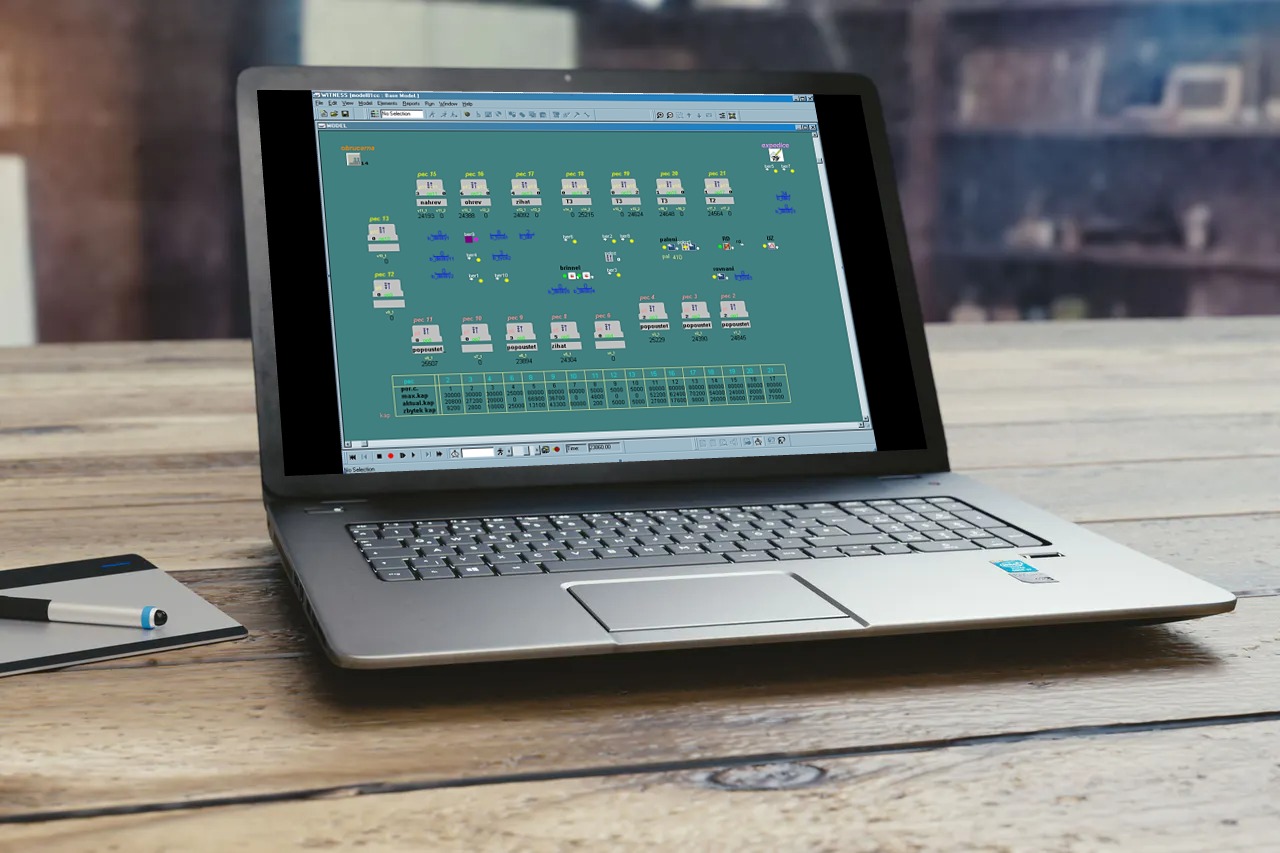One of the First Projects of Dynamic Future: Simulation 20 Ago vs. Today

“Back then, we used to be contacted by great visionaries only,” says Petr Jaluvka, one of the executive heads about the time when DYNAMIC FUTURE was just starting with its activities. It’s worth looking back and comparing what digital twins looked like back then and today. Let’s quickly remember the project Kovárna Kunčice.
A smithy with sophisticated technology
The goal of the assignment was to increase the permeability and planning regarding off-production of one of the forge operation sections, using a simulation model created in the Witness interface. The customer needed to increase the capacity at the smithy, therefore increase its permeability. He wanted to get a press use analysis, find the weak spots of the production, minimize the area needed for it and set the production line permeability regarding product composition and shift work organization. He also required a reduction of staff by 40 %.
“It was needed to work with a relatively intricate technology – the smithy had several forge types. Before every forging, the forged piece had to be heated up. However, considering the size of the pieces, one product was forged several times, so everything went cold quickly. Forging one piece was a relatively long procedure and most time was consumed by heating up the forges”, says Jan Slajer, the second of the executive heads. The colleague states that thanks to this finding, they also examined the investment to the reconstruction of one of the forges. “Based on the input of our model, the shop eventually made the investment.”
Without digital data
In the very beginning, there was a data analysis (now logistics audits are made), which was not an easy task to pull off in 2000. “In case of the smithy, we didn’t have any digital data, everything was written down in the forge books. And they had to be rewritten on the computer. The smithy was focusing on custom production and part of the assignment was to reduce the number of employees. Such a drastic requirement is not very common these days”, states Petr Jaluvka.
DYNAMIC FUTURE created a model of the given forge’s section in Witness 2000 so that it was possible to monitor individual production forges with other sections, as well as the operations related to a specific product taking place in those. The fullness of individual forges was tabulated, as well as free capacity and usage of other workplaces. A set of variables enabled changing the period of goods processing on individual sections (duration of staying in the forges, duration of shape forging etc) and therefore simulating connecting various products with the same technology to groups or changing the processing technology (temperature diagrams etc).
“The link between ideas and reality was very indirect back then. When the employees reported the amount of tonnes produced, nobody questioned it. When we came with a digital model and analyzed hard data, the company management gained a completely new perspective. If somebody said that the product always takes a different period, we asked why. We looked for additional manipulations, could evaluate them and quickly incorporate them in the monitored system elements. We helped to clear out the operational blindness that arises in every company,” described P. Jaluvka.
Production plan optimization brought results
A digital twin model pointed out the factors influencing the production in this specific case. Among them, there was a very diverse range of goods from various suppliers, several technological processing of many products, the possibility of hidden defects complicating the planning, occurrence of defects and waiting for a receiver and test results. That all reduced the production’s permeability. “The first input was to recommend the steps to increase the mentioned permeability, the second was continuous work on production optimization. The customer was sending us requirements, we ran them through the model in Witness and sent him the optimal production plan. It outlined the way to compose it in order to have the smithy evenly occupied and achieve the permeability that he needs and therefore meet the customer demands,” described J. Slajer.
And the results? Among others, there was reduction in time the products spend in pressing forges by 3 % in 2 months, specifically 859 hours; reduction in manufacturing time of propeller’s shaft by 54 % on average, increase in the number of shipped products by 9,5 %, increase in the press usage by 7,2 %.
The model was linked to an Excel file (or similar input files) with the structure created by the professionals of DYNAMIC FUTURE. For the customer, it was an environment that wasn’t user friendly, that’s why he let the analyses to be processed externally by DYNAMIC FUTURE.
Digital twins as an application
“The current digital twins have a different level,” says P. Jaluvka, and added that for performance mapping, MES systems etc. are used today: “Modern processes are surrounded by a lot of sensors, data gathering is therefore much easier. Another change is the way in which the customer can work with a simulation model – we create a standardized model called Manager. Within it, we will agree on how the client is going to put input data, what they are going to look like… We basically deliver an application in which the simulation model can be controlled. The client only needs to have a Witness Viewer license purchased.”
The client then gets a tool in which it’s possible to simulate and check any change that is happening in the company processes. Without needing to contact DYNAMIC FUTURE and spending more money.
The result is however the same as today: streamlining processes, reduction of the number of downtimes and errors, production permeability increase, cost optimization.
Related articles
Jun 7, 2024
DJI introduces its first delivery drone
DJI introduces its first delivery drone
Jun 7, 2024
5 expert insights into the world of dynamic simulations and logistics
5 expert insights into the world of dynamic simulations and logistics
Apr 2, 2024